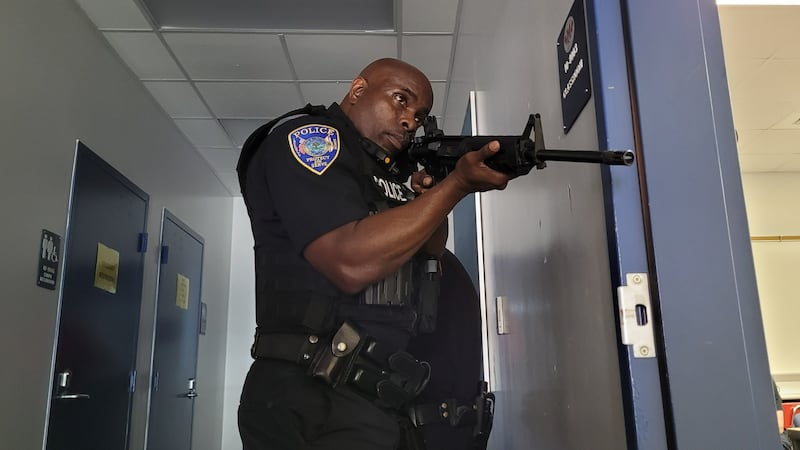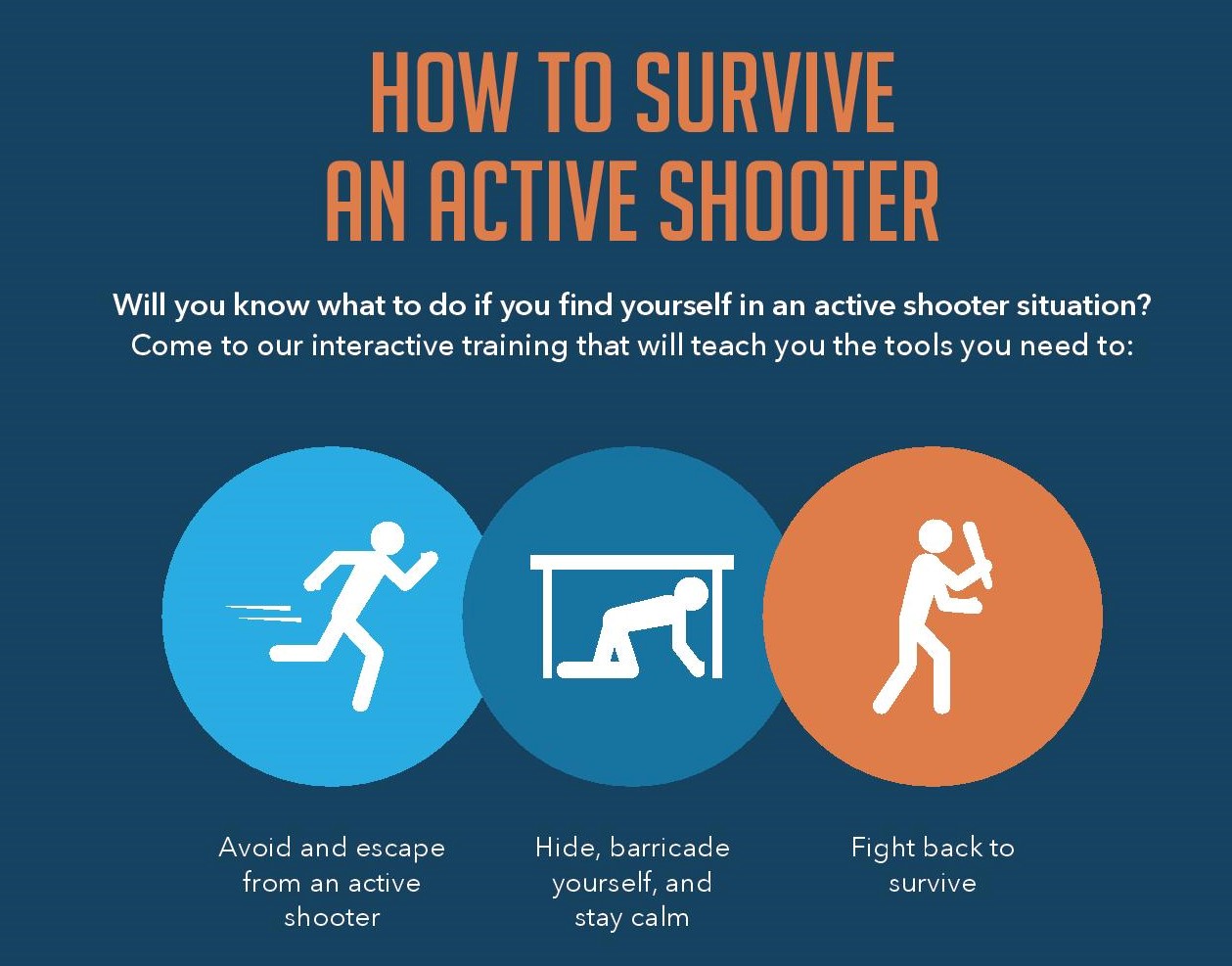The Benefits of Continuous Active Shooter Training for Area Security
The Benefits of Continuous Active Shooter Training for Area Security
Blog Article
Implementing Active Shooter Training: Finest Practices for Developing a Safe and Prepared Community Environment
As areas confront the disturbing truth of active shooter events, the application of comprehensive training programs comes to be necessary. A successful technique hinges on not only the development of tailored curricula that address local risks however also the involvement of varied stakeholders. By utilizing a selection of training approaches, neighborhoods can make certain that all participants are furnished with crucial abilities. Nevertheless, the obstacle hinges on maintaining a flexible structure that evolves with arising dangers. What are the vital elements that can change a conventional training program into a robust model for neighborhood resilience?

Understanding the Requirement for Educating
In an age noted by increasing events of physical violence in public spaces, comprehending the requirement for energetic shooter training has never ever been a lot more vital. Extensive training campaigns can furnish individuals with the understanding and abilities to react emphatically.
In addition, the emotional impact of physical violence on individuals and neighborhoods can not be overemphasized. Training fosters a feeling of empowerment and readiness, enabling individuals to really feel even more secure in their environments. It additionally promotes a culture of security, where recognition and caution become indispensable elements of every day life. The benefits of energetic shooter training prolong beyond prompt response; they consist of improving interaction methods and boosting overall security procedures within companies.
Secret Parts of Effective Programs
Efficient active shooter training programs incorporate a number of essential components that boost preparedness and response capacities. First, extensive curriculum growth is necessary, making certain that training web content is appropriate, evidence-based, and customized to the particular needs of the organization or area. This includes understanding the characteristics of energetic shooter incidents and the mental effect on people included.
2nd, practical training situations must be used to replicate possible situations, permitting participants to practice decision-making and reaction strategies in a controlled setting. These drills help with muscle memory and develop self-confidence among individuals.
Third, a concentrate on interaction protocols is important. Developing clear lines of communication among legislation enforcement, emergency -responders, and individuals guarantees collaborated responses during an incident. Routine updates and refresher courses aid keep interaction paths clear and efficient.
Fourth, recurring assessment and comments mechanisms should be incorporated right into the training program - active shooter training. Evaluating the efficiency of training with participant comments and performance metrics permits continuous renovation
Last but not least, cultivating a culture of safety and security and preparedness within the neighborhood encourages caution and proactive actions, ensuring that people are not only trained but also involved in maintaining a safe atmosphere.
Engaging Neighborhood Stakeholders

To successfully engage these stakeholders, it is necessary to interact the goals and benefits of the training. Organizing educational sessions can help clear up the training's function, address worries, and detail the duties each stakeholder navigate here may play. In addition, developing a stakeholder advising committee can facilitate continuous discussion, enabling for diverse perspectives and insights to be integrated into the training program.
Structure connections with neighborhood leaders and organizations is also critical. Their support can enhance outreach efforts, increase participation, and make sure that training is tailored to the one-of-a-kind needs of the area. In addition, stakeholders can help in disseminating information look at this website and resources, strengthening the message of safety and preparedness.
Eventually, engaging neighborhood stakeholders not only strengthens the training initiative but also cultivates a sense of ownership among homeowners, leading to an extra resilient and enlightened neighborhood qualified of responding properly to possible risks.
Training Shipment Approaches
Utilizing a variety of training shipment techniques is necessary to fit the diverse discovering designs and needs of participants in energetic shooter training programs (active shooter training). Reliable training can take numerous forms, including talks, hands-on simulations, online modules, and interactive workshops. Each method serves a distinct function and can enhance the overall discovering experience

On-line components offer versatility and ease of access, allowing individuals to find out at their very own pace. These can consist of videos, tests, and discussions to determine understanding. Interactive workshops motivate seminar and analytic, promoting teamwork and communication skills.
Incorporating a combined approach that integrates these methods not just enhances the training experience but likewise makes sure that individuals are much better prepared to respond efficiently in the occasion of an energetic shooter scenario (active shooter training). By dealing with numerous learning preferences, organizations can create a more educated and responsive neighborhood
Continual Evaluation and Enhancement
Normal analysis and enhancement of active shooter training programs are crucial to preserving their significance and performance. As threats develop, so must the techniques and techniques used in training. Continual examination guarantees that training web content hop over to here shows the most current knowledge on energetic shooter events, including lessons learned from recent occasions and readjusting for arising patterns.
To facilitate this procedure, companies ought to develop responses systems that include individual examinations, professional evaluations, and occurrence debriefs. Gathering information on participant performance throughout drills and exercises is vital, as it highlights areas requiring improvement and informs future training sessions. In addition, engaging with law enforcement and emergency situation responders can supply important insights right into the usefulness and applicability of training protocols.
Consistently arranged evaluations of training products and methods need to be mandated, cultivating an atmosphere of advancement and flexibility. Organizations must also urge a culture of recurring understanding, where personnel feel empowered to recommend modifications based on their experiences. By devoting to continual assessment and improvement, companies not only boost the effectiveness of their energetic shooter training programs yet likewise strengthen their general dedication to safety and security and readiness within the area.
Final Thought
Finally, effective implementation of active shooter training demands an extensive strategy that prioritizes community involvement and sensible simulations. By establishing tailored curricula, integrating varied training methods, and fostering partnership among stakeholders, neighborhoods can enhance readiness. Continuous analysis and feedback systems are important for adapting programs to emerging threats, consequently enhancing total security. Inevitably, a dedication to ongoing training and renovation cultivates a society of watchfulness and readiness, guaranteeing a much safer setting for all community members.
Report this page